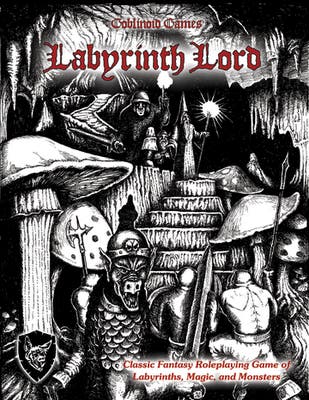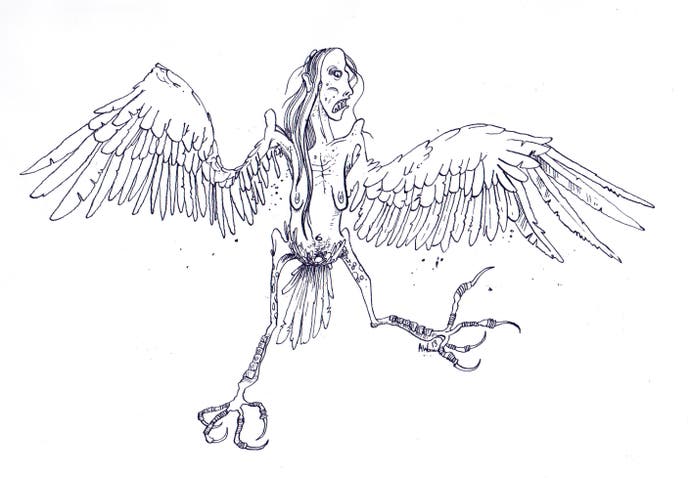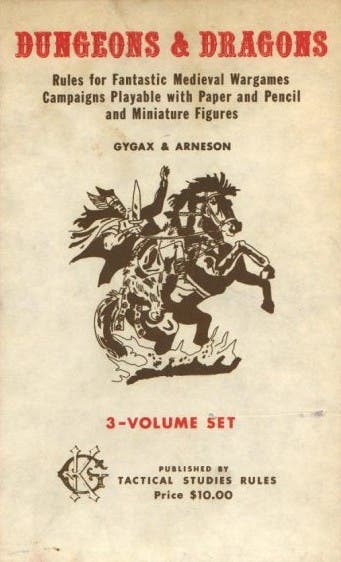Stories with dice: the thrill of old-school D&D
When is a role-playing game not a role-playing game? Most of the time, it turns out.
A few weeks into January and I've already had what could well be the most exciting, enveloping gaming experience I'll have all year. It will certainly be hard to top, at any rate. I've been introduced to this weird, underground tabletop game that's unlike anything you've ever played before: a little thing called Dungeons & Dragons. (Actually, it's not, it's called Labyrinth Lord. But I'll get to that.)
I'm being facetious, of course. Dungeons & Dragons, the fantasy wargame that all but created the genre of role-playing games, is a massively influential piece of pop culture, a true 20th-century classic. Its influence extends far beyond its actual practice, which, 40 years on from its first publication, is still seen as a strange secret world, a hobby that's too nerdy for most nerds. This, combined with the fact that it's an inherently social game that you need to be initiated into - more so even than, say, poker - is why even a long-time gamer like me had never played it before.

(Actually, this is a white lie - I have a dim memory, like a scene from a nostalgic Shane Meadows film, of playing it in the study of an odd friend when I was a 16-year-old private schoolboy. You can picture the scene: school ties akimbo, blazers on the floor, cheap WHSmith A4 pads resting on nylon-clad knees, KLF bootlegs on the boombox. But the recollection is sufficiently indistinct that it might as well not have actually happened to me.)
When my friend Andrew suggested introducing a bunch of us to the game, I was eager. I had an obvious professional interest in playing it, since D&D is a key text for the video game medium. Aside from being a progenitor of virtually every computer role-playing game, it fostered a generation of game designers, had a very direct hand in the establishment of major studios like BioWare - whose early games ran on variations of the D&D rule set - and also, through its emulation in multi-user dunegons, or MUDs, on early computer networks, was the starting point for massively multiplayer online worlds. (You could even argue that, as a game with a strong emphasis on storytelling and simulating a fantasy world, it prefigures a much broader swathe of video games than just RPGs.) Plus, it sounded pretty fun.
Andrew was our dungeon master - the player who "plays" the monsters and non-player characters, referees the action and tells the story, whether it's a published campaign or something they've written themselves. He ran a short adventure of his own design for the five of us, intended to last for a single session of around six hours. Everyone else at the table was a neophyte like me.
We rolled dice to determine our characters' stats. I was interested in the cleric class, a sort of holy fighter with powerful prayers instead of spells, but I rolled low intelligence and charisma and high strength and constitution. This is where the magic started to happen in the space between luck, the game's rules, and my imagination. I decided my cleric was a burly, dim, crusader type serving a decadent, materialistic church, and he came to life. It suddenly came to me that he was a functioning alcoholic, so I bought loads of wine along with his equipment and armour. Improvising around my improvisation, Andrew decided that I would have a chance to regain hit points by taking a slug of booze.
Andrew took us to a beer tent with baboons tied up outside; introduced us to militia with painted faces, mad barkeeps and rich tourists; led us across a barren landscape to a tower inhabited by tiny, blue homunculi; and finally unveiled a necromancer's clifftop dungeon, adorned with a pyramid and guarded by a terrifying harpy (which he'd drawn for us - see below). He served up some good old-fashioned fantasy adventure, too: giant rats, creaking rope bridges, scimitar-wielding skeletons, things that go bump in the dark.

Once in the dungeon, we advanced into the unknown with caution, wary of traps and foes that could decimate our hit points with a single blow, and didn't think twice about running away. An early encounter with those skeletons left two of us incapacitated and one seriously wounded. We soon wised up; there were things here that were stronger than us, our resources were limited, and we were at genuine risk of death. It was dark. It was scary.
Naturally I went in looking for similarities with video games, and naturally I found some. Some were obvious, like the strong sense of identification I had with my character being a similar feeling to playing World of Warcraft (although it was striking how quickly this developed). Some were more surprising: the fearful, threatening and strange mood of our adventure and its inherent danger had more in common with Dark Souls, a Japanese action-RPG, than with the modern American RPGs that can draw a direct line to D&D in their family trees.
What I wasn't prepared for were the stark differences. Even the best computer RPGs merely allow role-playing. Dungeons & Dragons requires it. To succeed in D&D - and to have the best time in it - you need to inhabit your character, see through their eyes, think how they think. To fight well, solve puzzles and find secrets, you need to exercise your imagination and wit in ways that are entirely complementary with acting the part of your character. The freedom of action given to you is tremendous - it's literally anything you can think of that the dungeon master agrees is feasible. And that's the next point: imagine playing a game where the creative director, or lead content designer or whatever, is sat right next to you, and they're role-playing too - adapting the game's story, rules and pacing on the fly, according to your actions.
Even the best computer RPGs merely allow role-playing. Dungeons & Dragons requires it

It's no surprise that attempts to replicate this dynamic in the more structured, one-way delivery of a video game end up missing something, or creating friction between the role-playing and the game. Think of the nature-loving Druid in WOW who is encouraged by the quest design to slaughter wildlife by the bucketload. Think of the single-player BioWare adventures that try to codify this free-form story-jamming in huge matrices of choice, cause and effect - but in doing so end up reducing it to a kind of narrative database.
So I left our session thinking that, even 40 years on, video games still have a lot to learn from Dungeons & Dragons. But there's a twist - something I didn't know, although readers familiar with D&D might already have figured it out. There's a lot that Dungeons & Dragons still has to learn from Dungeons & Dragons.
In the middle of our session, Andrew revealed that we weren't playing the game as it is played today, not officially at any rate. We were playing a game called Labyrinth Lord which replicates, in a modern, digestible form, Dungeons & Dragons as it was played in 1981 - specifically, the D&D basic set, edited by Tom Moldvay. It's published by Goblinoid Games under the Open Game Licence; it turns out there's a whole subculture dedicated to these unofficial throwbacks. Another example is Swords & Wizardry, which is based on the 1974 original edition, or "0e" as the lingo has it.
We were playing Labyrinth Lord partly because that's just the kind of guy that Andrew is - the kind who still listens to his Slayer albums on cassette tape - and partly because the rules are much simpler, so it's easier and quicker for new players to get into. But, as I've learned while reading around the topic this week, there's a also a real and very important distinction between the game as it was played then and as it's played today; a shift in design and philosophy that has its roots in a great schism that occurred very early in Dungeons & Dragons' life.
In 1977-8, the game bifurcated into "basic" and "advanced" editions. Original designer Gary Gygax turned Advanced D&D into an ever-expanding rule set that sought to elaborate the game mechanics and tighten the structure, creating rules for every conceivable situation, tidying up the mess. J Eric Holmes and, later, Moldvay, editing the basic game, embraced the mess, trying to keep its freewheeling improvisation intact. There were some dramatic differences in the rules, and even greater differences in the feel of play. Basic D&D encouraged Dungeon Masters to interpret and create rules, to riff, to allow for random happenstance. AD&D encouraged them to turn themselves into walking rule encyclopedias and create strictly balanced gaming challenges. A debate rages about the relative merits of these two styles to this day.

In the years since it bought the Dungeons & Dragons licence, Wizards of the Coast has sought to unify the two streams in the third and fourth editions of the game; the fifth is due this year. Apparently it's had some success streamlining the unwieldy AD&D rules, but the damage, if you want to call it that, to the game's more improvisational side has been done. (You might also note that, by making it so easy for players to create their own rules and content, the simplicity and flexibility of old-school D&D makes it less suitable for the publication of endless supplements and campaigns.)
The profound difference between classic and modern D&D is explained in Matt Finch's A Quick Primer for Old School Gaming, which is available as a free download. It's a short and wonderfully lucid and entertaining read, and though aimed at modern role-players I'd recommend it to anyone with an interest in gaming in all its forms. In particular, Finch's four "zen moments" are an electrifying manifesto for a kind of adventuring that, in video games too, has been all but lost in our desire to smooth the edges off our virtual worlds, to break them down into carefully designed systems rather than raw ideas. One part in particular, titled "Forget 'Game Balance'", made my hair stand on end:
"The old-style campaign is with fantasy world, with all its perils, contradictions, and surprises: it's not a 'game setting' which somehow always produces challenges of just the right difficulty for the party's level of experience. The party has no 'right' only to encounter monsters they can defeat, no 'right' only to encounter traps they can disarm, no 'right' to invoke a particular rule from the books, and no 'right' to a die roll in every particular circumstance. This sort of situation isn't a mistake in the rules. Game balance just isn't terribly important in old-style gaming. It's not a tournament where the players are against the GM. It's more like a story with dice: the players describe their actions, the referee describes the results, and the story of the characters, epic or disastrous, grows out of the combined efforts of referee and players. The referee will be just as surprised by the results as the players are."
If you play games for the same reasons I do - to be transported, amazed and entertained by impossible worlds - you've got to want to experience that. Last weekend, when one of our party pulled a tiny blue corpse out of her bag and dumped it in a magic fountain and all hell broke loose, to name just one incident, I certainly did.
I feel like a fraud and an arriviste extolling the virtues of this unique gaming experience after just one session, but I just can't shut up about it. Can video games learn something from classic D&D? Probably, although the current trend for rough and unpredictable sandbox games, from Minecraft to Starbound, suggests that they might be figuring it out on their own. Even those games can't provide quite the same thrill as an old-school Dungeons & Dragons session, though, so I urge you to get some friends together around a table and some dice, and watch a story come to life before your very (mind's) eyes. There's nothing like it.
Thanks to Andrew Walter for the harpy illustration - and the background info, and the great time. You can download a free version of Labyrinth Lord, and buy print and e-book copies, from Goblinoid Games.

